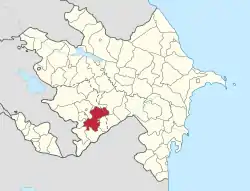Tuğ
Tuğ (Tugh) or Togh (Armenian: Տող) is a village in the Khojavend District of Azerbaijan.
Tuğ
Տող • Togh | |
|---|---|
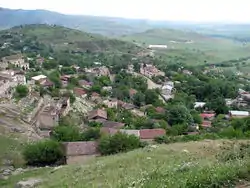 | |
 Tuğ | |
| Coordinates: 39°35′06″N 46°57′55″E | |
| Country | |
| District | Khojavend |
| Elevation | 800 m (2,600 ft) |
| Population (2005)[1] | |
| • Total | 679 |
| Time zone | UTC+4 (GMT +4) |
| • Summer (DST) | UTC+4 |
History
Tugh and the neighbouring fortress of Ktishberd, are first mentioned in the 9th century, as the capital of the Principality of Dizak.[2] Here in 854, Esayi Abu-Muse, the Prince of Dizak, defeated a 200,000 strong Arabian army under the command of Bugha al-Kabir.
In 1737, Armenian Prince Melik Yegan built a palace here. The principality would go on to survive until the last prince, Yesayi Melik-Avanian, was killed by Ibrahim Khalil Khan in 1781, after a long-lasting resistance in the fortress of Ktishberd. Tugh was a part of the Karabakh Khanate until 1822 when it was annexed by Russia and became part of the Elisabethpol Governorate.
In 1903 a hospital was built and three years later a village school was opened which today functions as a middle school.[2] A new school was built in 1978, which was renovated for the first time in 2008 by the Armenia Fund.[3] There is also a house of culture, a movie theater and a library.[2]
In addition to nearby Gtichavank Monastery[2] there are nearby ruins of some churches including Stepanos Nakhavkayi Church of the 13th century.[2] The village church is named Saint Hovhannes and was built in 1736.[2] A few of the Yezanyan Meliks are buried in the yard of Saint Hovhannes Church.[2]
In March 1988, Armenian armed militia detachments were formed to defend the village from Soviet and Azeri attacks during the First Nagorno-Karabakh War, and lives were lost.[2] Tugh was captured by Azeri forces but was recaptured by the Armenian Army on October 30, 1991.[4] As a result of the war ethnic Azeri villagers were forced to flee and many settled in Beylagan Rayon. Since its capture, the village came under de facto control of the self-proclaimed Republic of Artsakh as part of its Hadrut Province.[2]
The region is now known for wine-making.[5] Home-made wine is very common in Tugh. The "Kataro Winery" of Tugh was opened by the Avetissyan family in the Kataro vineyards in 2010.
The village had an Armenian majority prior to its recapture by Azerbaijan on October 9, 2020 during the 2020 Nagorno-Karabakh war.[6][7]
Population
In 1921, there were 1,589 Armenians living here. In 1974, there were 1,228 inhabitants in the village,[2] and in 1987 there were 1,421 inhabitants.[2] Two years later, 920 Azerbaijanis and 700 Armenians were recorded.[8]
Memorial wrote about the forced exodus of the Azerbaijani inhabitants of the village, along with several other Azerbaijani villages around the area.[9]
In 2005, the population was 679 Armenians.[1]
Gallery
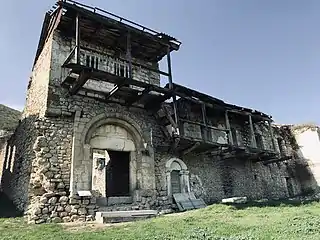 From the buildings of the royal palace of the village
From the buildings of the royal palace of the village.jpg.webp) Preserved buildings of the royal palace of the village
Preserved buildings of the royal palace of the village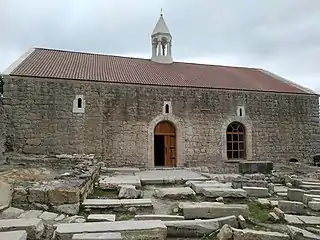 St. John the Baptist Church in the village
St. John the Baptist Church in the village.jpg.webp) Third Annual Artsakh wine festival in the village
Third Annual Artsakh wine festival in the village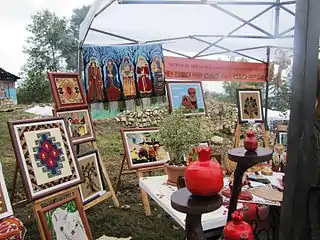 Exhibition of artworks at the Artsakh wine festival in the village
Exhibition of artworks at the Artsakh wine festival in the village
Notable Natives
- Javad Malik-Yeganov, Azeri Governor-General of Lankaran
- Aslan Mukhtarov, Azerbaijani scientist, recipient of the USSR State Prize.[10]
- Ayriev Armen Tevanovich, Armenian Hero of the Soviet Union
- Vigen S. Grigoryan, Armenian battalion commander during the First Nagorno-Karabakh War
References
- Results of 2005 census of the Nagorno-Karabakh Republic.
- (in Armenian) T. Kh. Hakobyan, St. T. Melik-Bakhshyan, H. Kh. Barseghyan «Երևան» (Yerevan). Dictionary of Toponymy of Armenia and Adjacent Territories. vol. v. Yerevan, Armenia: Yerevan State University Press, 2001, pp. 117.
- Reconstruction of Togh Village School Completed
- NKR President: Togh Liberation Was Historically Important
- https://hetq.am/eng/news/54717/made-in-artsakh-kataro-wine-breaks-into-armenian-and-russian-markets.html
- "Карта 33. Зона конфликта в Нагорном Карабахе (1988–1994...)". iriston.com.
- "Daha 23 kənd işğaldan azad edildi". report.az (in Azerbaijani). 9 November 2020.
- "ЭТО УЖЕ НЕ ТОТ ТУГ" (in Russian). 15 September 1989.
It is home to 920 Azerbaijanis and 700 Armenians. The Armenians found their homeland, but we, as it were, were left without it.
- "СОБЫТИЯ, ПРЕДШЕСТВУЮЩИЕ ШТУРМУ ХОДЖАЛЫ". memo.ru (in Russian). Memorial.
- Azerbaijani Soviet Encyclopedia. V. I.
| Wikimedia Commons has media related to Tug. |

